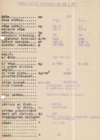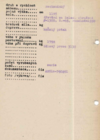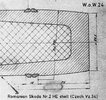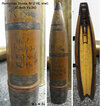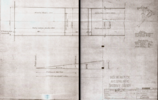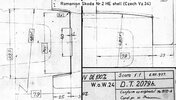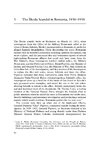British Ordnance Collectors Network
You are using an out of date browser. It may not display this or other websites correctly.
You should upgrade or use an alternative browser.
You should upgrade or use an alternative browser.
100 mm HE, Skoda / Yugoslavia
- Thread starter Przemek
- Start date
Thanks for further info.
Below is a photo of the remains of the brass cover/tube.
Czech projectiles were tested in Poland - shrapnel and HE vz.28 (when selling licenses / 1928). Only the wz.28 shell was adopted.
I have no further information about these tests [other types of shells].
I was wondering if this copy could have come from testing. However, from what you write, it's probably a German thing [in the 1940s].
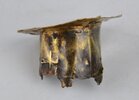
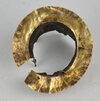
Below is a photo of the remains of the brass cover/tube.
Czech projectiles were tested in Poland - shrapnel and HE vz.28 (when selling licenses / 1928). Only the wz.28 shell was adopted.
I have no further information about these tests [other types of shells].
I was wondering if this copy could have come from testing. However, from what you write, it's probably a German thing [in the 1940s].


@Przemek
The problem with looking for those period documents is that the company archives are not inventoried. So it takes years to search for something according to the cardboard from No. 1 to No.*. Then there is the possibility to search (in the export section) in military documents (the army commented on this), it is indeed possible, but ... the soldiers have allowed that the company can make an offer to another country, but that is only the basic framework. If it wasn't the samples of ammunition and weapons introduced in the army, they basically didn't follow specific documents anymore and didn't want to send drawings, etc. It could happen that the company wanted to approve it because it conflicted with the interests of the army and that's why some part of the documents about that specific offer was preserved. It's a search, and it's a long, expensive and slow job
Akon
The problem with looking for those period documents is that the company archives are not inventoried. So it takes years to search for something according to the cardboard from No. 1 to No.*. Then there is the possibility to search (in the export section) in military documents (the army commented on this), it is indeed possible, but ... the soldiers have allowed that the company can make an offer to another country, but that is only the basic framework. If it wasn't the samples of ammunition and weapons introduced in the army, they basically didn't follow specific documents anymore and didn't want to send drawings, etc. It could happen that the company wanted to approve it because it conflicted with the interests of the army and that's why some part of the documents about that specific offer was preserved. It's a search, and it's a long, expensive and slow job
Akon
Last edited:
| Archiwum | Zespół | Sygnatura | Tytuł jednostki | Data | |
| Centralne Archiwum Wojskowe | Departament Sprawiedliwości Ministerstwa Spraw Wojskowych | I.300.58.162 | Sprawy konsultacji prawnej dotyczące umów i przetargów itp. - Firma Spraron, Wydropol, Samolot, Frankopol, Skoda. | ||
| Biuro Administracji Armii Ministerstwa Spraw Wojskowych | I.300.54.312 | Korespondencja firm "prywatnych dostawców dla wojska - Polskich Zakładów Skoda", Fabryki Obrabiarek "Pionier", "Polskich Zakładów Optycznych", Zakładów Amunicyjnych "Pocisk" i Fabryki Motorów "Perkun". | 1927-1932 | |
| Centralne Archiwum Wojskowe | Oddział I Sztabu Generalnego | I.303.3.712 | Zakup w Czechosłowacji sprzętu artyleryjskiego. Referat na temat produkcji haubic w kraju i warunków technicznych haubic 100 mm zamówionych w fabryce „Skoda”; referaty w sprawie rozbudowy artylerii najcięższej i pertraktacji dot. zawarcia umowy ze „S | 1926-1930 | |
| Centralne Archiwum Wojskowe | Departament Uzbrojenia Ministerstwa Spraw Wojskowych | I.300.35.77 | Korespondencja w sprawie zakupu haubic 100 mm w firmie "Skoda" w Czechosłowacji. | 1927-1930 | |
| Centralne Archiwum Wojskowe | Towarzystwo Starachowickich Zakładów Górniczych SA | I.364.1.10 | Korespondencja w sprawie warunków technicznych amunicji 100 mm, instrukcja wzmacniania dna pocisków. | 1928-1930, 1936, 1939 | |
| Towarzystwo Starachowickich Zakładów Górniczych SA | I.364.1.14 | .... | ..... | |
Last edited:
I scan around 1100 pieces every time I visit the archive. Well, over the years I've been working on it, it's enough. I have an A3 scanner...(Plustek Optic Slim 1180)Exactly, I already have some copies of papers from CAW ~ 50,000+, but there is still a lot to do : )
I am especially interested in my own inventory for the archival fund, and that is more than 15 years of work.
I don't just scan something when I decide to scan the entire pool completely.Akon
wingsofwrath
Well-Known Member
So, a bit of an upset in the Skoda shell saga - while I was away for a week, @Irod7 managed to get his hands on better quality scans of the plans for the Nr.2/ Vz.34 HE shell and, to our surprise, the distance from the rotating band to the bottom is actually 79mm, not 70mm as we assumed (you can see the image we were working from in his reply on page 1 of this thread and you can barely make up a "7" as the first digit but not the other one, and, because the distance on the other shell is 69mm, we rightly assumed it to be an even 70mm...)
The other things like the radius of the lower ogive still stand - R=480, with an R=3 fillet where it meets the bottom.
Also, here are a few pictures of a cutaway example of the No.2 shell in original paint, inexplicably displayed in the Maritime Museum in Constanta alongside a few other examples of land-based artillery - our guess is they actually belong to the Constanta branch of the National Military Museum and they are exhibited here due to lack of space in their building.
Please excuse the rather poor quality of the middle picture - I was in a bit of a rush last time I was there and was actually looking for something entirely different, but snapped a few pictures of this one as well just because I was there. I'll take better pictures next time I'm in the neighbourhood.
The other things like the radius of the lower ogive still stand - R=480, with an R=3 fillet where it meets the bottom.
Also, here are a few pictures of a cutaway example of the No.2 shell in original paint, inexplicably displayed in the Maritime Museum in Constanta alongside a few other examples of land-based artillery - our guess is they actually belong to the Constanta branch of the National Military Museum and they are exhibited here due to lack of space in their building.
Please excuse the rather poor quality of the middle picture - I was in a bit of a rush last time I was there and was actually looking for something entirely different, but snapped a few pictures of this one as well just because I was there. I'll take better pictures next time I'm in the neighbourhood.
Attachments
@wingsofwrath
it's important to get the distance from the bottom and confirm the radius on this type (No.2). If the ammunition is completely manufactured in Skoda, I give it more confidence that it corresponds to the company's drawings and production procedures on the machines that the ammunition factory used. Licensed production in another country had minor or major deviations in the production design. The production design can therefore be distinguished according to these fine details. There is a lot of room for research here. After the explosion of the ammunition there is a fragment and this is the basis for comparison to the sample, drawings, etc.
Akon
it's important to get the distance from the bottom and confirm the radius on this type (No.2). If the ammunition is completely manufactured in Skoda, I give it more confidence that it corresponds to the company's drawings and production procedures on the machines that the ammunition factory used. Licensed production in another country had minor or major deviations in the production design. The production design can therefore be distinguished according to these fine details. There is a lot of room for research here. After the explosion of the ammunition there is a fragment and this is the basis for comparison to the sample, drawings, etc.
Akon
wingsofwrath
Well-Known Member
There are several drawings in the file and they all confirm the 79mm distance, R=480mm ogive with a R=3mm fillet. There are even a few drawings for the gauges and jigs for checking conformity and they show it as well.
Now, speaking of conformity, the drawings also bear the inscription "conforming to the original XX-YYYY-Z" where the latter is a drawing number like "Mu 1872-A", "Mu 1876-A", etc. which I'm assuming are numbers from the original Škoda documentation package. The drawings themselves were made at the Costinescu ammunition factory in Sinaia, even though they were found in the archives belonging to the Astra Brasov ammunition plant and all the jigs are marked as being made in Brasov... but also not by Astra, but by the "engines" section of the aircraft manufacturer IAR. From the dates, all of this was going on in 1937, so this is well pre-war.
Also, I wanted to point out that even on the drawing which started this topic you can actually see the 69mm-79mm as well as the curvature difference if you place the two shells side by side, so that's further confirmation this was a change implemented by Skoda to all of their export customers.
Finally, there is a bit of documentation from a Romanian manual I'm not at liberty to show which describes the "Nr.3" (Vz.30) shells and they're all called that regardless of wherever they are the "exploziv" ("explosive") direct action HE fitted with the regular CHZR / SKHZR fuzes or the "fuzant" ("timed") time-and-percussion HE fitted with the VG-CR / VG-SKR, even though the latter uses a different range table, it's not listed as being manufactured in Romania at all and only shown in either German or Czech markings.
From that, I conclude that they wouldn't have made a distinction between a direct action "Nr.2" (Vz.34) and a time-and-percussion one either, so you could rightfully class the VG-CR / VG-SKR equipped 10-cm Sprgr (Dopp.Z) 311 (j) as a "Nr.2".
Now, speaking of conformity, the drawings also bear the inscription "conforming to the original XX-YYYY-Z" where the latter is a drawing number like "Mu 1872-A", "Mu 1876-A", etc. which I'm assuming are numbers from the original Škoda documentation package. The drawings themselves were made at the Costinescu ammunition factory in Sinaia, even though they were found in the archives belonging to the Astra Brasov ammunition plant and all the jigs are marked as being made in Brasov... but also not by Astra, but by the "engines" section of the aircraft manufacturer IAR. From the dates, all of this was going on in 1937, so this is well pre-war.
Also, I wanted to point out that even on the drawing which started this topic you can actually see the 69mm-79mm as well as the curvature difference if you place the two shells side by side, so that's further confirmation this was a change implemented by Skoda to all of their export customers.
Finally, there is a bit of documentation from a Romanian manual I'm not at liberty to show which describes the "Nr.3" (Vz.30) shells and they're all called that regardless of wherever they are the "exploziv" ("explosive") direct action HE fitted with the regular CHZR / SKHZR fuzes or the "fuzant" ("timed") time-and-percussion HE fitted with the VG-CR / VG-SKR, even though the latter uses a different range table, it's not listed as being manufactured in Romania at all and only shown in either German or Czech markings.
From that, I conclude that they wouldn't have made a distinction between a direct action "Nr.2" (Vz.34) and a time-and-percussion one either, so you could rightfully class the VG-CR / VG-SKR equipped 10-cm Sprgr (Dopp.Z) 311 (j) as a "Nr.2".
Attachments
@Winsofwrath
The drawings, i.e. the numbers you quote, apparently have an error in the labeling. i.e. "Mu 1872-A", "Mu 1876-A" the correct designation is therefore "Mu 1872a"; "Mu 1876a ,, When there was a change in the construction, they added a small letter "a", after the number so as not to waste the number series of drawings unnecessarily.I will try to verify the dating of that drawing, which is information that could be interesting.
In the Czech Republic, companies other than Skoda also had tool shops that produced tools and gauges and helped other companies.
Akon.
The drawings, i.e. the numbers you quote, apparently have an error in the labeling. i.e. "Mu 1872-A", "Mu 1876-A" the correct designation is therefore "Mu 1872a"; "Mu 1876a ,, When there was a change in the construction, they added a small letter "a", after the number so as not to waste the number series of drawings unnecessarily.I will try to verify the dating of that drawing, which is information that could be interesting.
In the Czech Republic, companies other than Skoda also had tool shops that produced tools and gauges and helped other companies.
Akon.
Small volume comparison 
Export of Romania : ( 1935‒1936)
80pcs 100mm howitzers vz. 30
168pcs. 100mm howitzers vz. 34
Export of Romania : ( 1937‒1938)
184pcs. 15cm Rough howitzers K 2
------------------------------------------------------
Export S.H.S (1927->
160 psc 7,5cm Horský kanon CD (M.28)
300 pcs 7,5cm Polní kanon EF (M.28)
72 pcs 10cm Polní houfnic FE (M.28)
20 ks 15cm Těžký kanon NO (M.28)
10 pcs 22cm Moždíř ON (M.28)
10pcs k 7,65cm PL kanonu -P (M.28)
Export S.H.S (1935->
36pcs. 7,5cm Horský kanon CD
24 pcs 10,5cm hrubých kanónů typ J
48 pcs 15cm hrubých houfnic typu K2
100 pcs 4,7cm protitankových kanónů A5
4 psc 14cm kanóny d/56 (Marine)
2pcs 8,35 cm PL kanónů d/55 (Marine)
12 pcs 12cm Kanon d/46 (Marine)
2pcs 10cm Ponorkové kanóny d/40 (Marine)
8pcs 8,35cm PL dělo d/55 (Marine )
etc..
Export S.H.S (1939->
40 pcs 7,5cm PL kanon R 3
80 pcs 8cm PL kanon vz.37
etc..
Akon
Export of Romania : ( 1935‒1936)
80pcs 100mm howitzers vz. 30
168pcs. 100mm howitzers vz. 34
Export of Romania : ( 1937‒1938)
184pcs. 15cm Rough howitzers K 2
------------------------------------------------------
Export S.H.S (1927->
160 psc 7,5cm Horský kanon CD (M.28)
300 pcs 7,5cm Polní kanon EF (M.28)
72 pcs 10cm Polní houfnic FE (M.28)
20 ks 15cm Těžký kanon NO (M.28)
10 pcs 22cm Moždíř ON (M.28)
10pcs k 7,65cm PL kanonu -P (M.28)
Export S.H.S (1935->
36pcs. 7,5cm Horský kanon CD
24 pcs 10,5cm hrubých kanónů typ J
48 pcs 15cm hrubých houfnic typu K2
100 pcs 4,7cm protitankových kanónů A5
4 psc 14cm kanóny d/56 (Marine)
2pcs 8,35 cm PL kanónů d/55 (Marine)
12 pcs 12cm Kanon d/46 (Marine)
2pcs 10cm Ponorkové kanóny d/40 (Marine)
8pcs 8,35cm PL dělo d/55 (Marine )
etc..
Export S.H.S (1939->
40 pcs 7,5cm PL kanon R 3
80 pcs 8cm PL kanon vz.37
etc..
Akon
Last edited:
wingsofwrath
Well-Known Member
Well, there's a very good reason for that, which is the so-called "Škoda Scandal" from 1930-34.Small volume comparison
Export of Romania : ( 1935‒1936)
80pcs 100mm howitzers vz. 30
168pcs. 100mm howitzers vz. 34
Export of Romania : ( 1937‒1938)
184pcs. 15cm Rough howitzers K 2
A certain Bruno Seletzky, who was the Škoda sales representative for Romania, in concert with a few Romanian Army officers like the general Sică Popescu (not "Gică" as the attached image calls him, as his middle name was Ștefan, not Gheorghe), then general secretary to the the war minister Henri Cihoski as well as career politicians like Romulus Boilă, a close friend of the then prime minister, Iuliu Maniu, conspired to defraud the Romanian state by negotiating a contract between Romania and Škoda in which the price presented to the Romanian side would be between 18-25% higher than what the factory was asking for and they'd pocket the difference. They also created the false impression that a competing bid by Schneider for the same contract was a lot more expensive than it really was.
And, to top it off, ol' Bruno was also doing a bit of military espionage, since in his safe he was found to posses a number of classified Romanian military documents, cypher books, etc.
In the end, only Seletzky spent 5 years in jail for destroying the secret documents before the investigation started (see attached image) and Popescu commited suicide in 1933. After he got out of jail Seletzky then went to Germany and bought, at a huge discount, a few factories from the Nazis which they'd "confiscated" from their former jewish owners. I'm not exactly sure what he did next, but he died in Czechoslovakia in 1958.
Anyway, the next governement managed to renegociate the contract with Škoda to a more reasonable price and the contract was fulfilled 1935-38 as you wrote, but all of this truly poisoned the well against Škoda, so the next armament contracts all went to Schneider instead - this also explains why the other mainstay of the Romanian Army's heavy artillery was the "Canon de 105L Mle.1936 Schneider" of which we contracted for 180 and got 132 before the start of the war.
Attachments
@Winsofwrath
Arms deals have always been a guarantee of corruption, apparently since ancient times. What was the framework of the domestic politics of Yugoslavia when between 1918 and 1929 there were twenty different governments ..... until finally a royal dictatorship was established .....>1929.
Yugoslavia also had major problems with the procurement of weapons and ammunition. Corruption reigned there at the highest levels to an unprecedented degree. Skoda only pragmatically accepted if it wanted to do business in this country. Because all sales representatives were paid as a percentage of paid orders. This puts enormous pressure on the business side of things. The context of the use of encryption procedures ...commonly used for the secrecy of business correspondence. Skoda and their sales representatives used (substitution) encryption practically from the beginning. Therefore, encryption tables are an essential part of business policy. In addition to company representatives who had territorial jurisdiction, there were also co-workers, informants, etc. who informed about the state, opinion or what more the state required. Škoda and Schneider had a cartel agreement and spheres of influence, so it will not be a free competition - competition about the price... (The Schneider–Škoda Alliance, 1919–1930, Jonathan A. Grant, Published online by Cambridge University Press: 2018)
PS : Bruno Seleczky: Born on April 14, 1886 in Zakopane (Poland), died on July 2.7.1958. Businessman, representative of Škoda in Romania in the interwar period. https://biblio.hiu.cas.cz/records/69a0e539-32b7-414b-ac7f-0bea57e58e31?locale=cs
Arms deals have always been a guarantee of corruption, apparently since ancient times. What was the framework of the domestic politics of Yugoslavia when between 1918 and 1929 there were twenty different governments ..... until finally a royal dictatorship was established .....>1929.
Yugoslavia also had major problems with the procurement of weapons and ammunition. Corruption reigned there at the highest levels to an unprecedented degree. Skoda only pragmatically accepted if it wanted to do business in this country. Because all sales representatives were paid as a percentage of paid orders. This puts enormous pressure on the business side of things. The context of the use of encryption procedures ...commonly used for the secrecy of business correspondence. Skoda and their sales representatives used (substitution) encryption practically from the beginning. Therefore, encryption tables are an essential part of business policy. In addition to company representatives who had territorial jurisdiction, there were also co-workers, informants, etc. who informed about the state, opinion or what more the state required. Škoda and Schneider had a cartel agreement and spheres of influence, so it will not be a free competition - competition about the price... (The Schneider–Škoda Alliance, 1919–1930, Jonathan A. Grant, Published online by Cambridge University Press: 2018)
PS : Bruno Seleczky: Born on April 14, 1886 in Zakopane (Poland), died on July 2.7.1958. Businessman, representative of Škoda in Romania in the interwar period. https://biblio.hiu.cas.cz/records/69a0e539-32b7-414b-ac7f-0bea57e58e31?locale=cs
Last edited:
wingsofwrath
Well-Known Member
Heh. The book I shared a page from is also one by Jonathan A. Grant: "Between Depression and Disarmament: The International Armaments Business, 1919-1939" also published by the Cambridge University Press in 2018.

